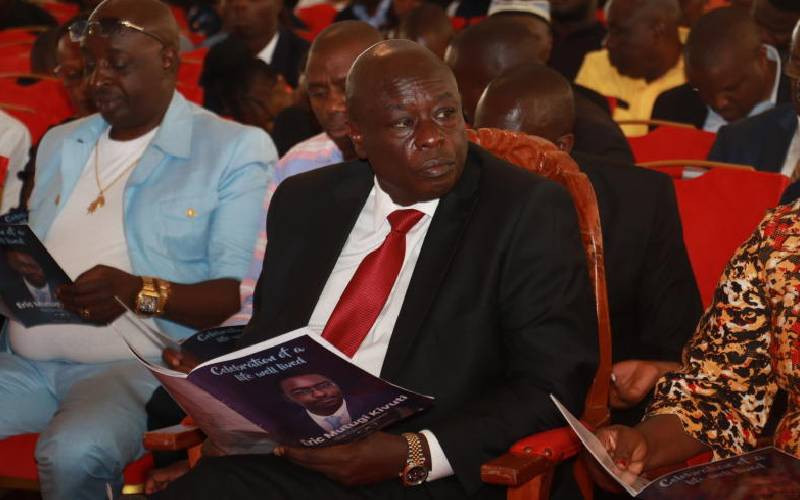
Banks have always been slow to catch up with new developments in their sector not because they do not see potential, but because they are extremely regulated.
They have to demonstrate that they are not taking up risky ventures.
It took banks years to catch up with M-Pesa when they finally launched PesaLink last year. It is said that they may have allowed telcos firm Safaricom too much time to be entrenched as the market leader to challenge it.
Before the price of loans was capped in September 2016, banks had warned that the law would push borrowers into the thorny embrace of loan sharks.
Two years later, and with the Banking Amendment Act, 2016 still firmly in place, commercial banks are morphing into loan sharks.
Banks, which are regulated by Central Bank are getting into unregulated activities which experts describe as shadow banking system.
The formal banking sector radical shift to the lower tier market is slowly taking shape. With interest caps limiting what banks can earn from the debt market, banks are now eyeing a share in the lucrative instant loan market up till now dominated by loan sharks.
Although the banks strongly deny taking this route, industry critics see their latest product line in direct competition with the informal instant loan operators who specialize in taking household items in exchange for quick loans.
Here, you submit an electrical appliance for a loan and then sign a contract. Breaching the contract means you lose the item and you cannot claim it once the repayment deadline has passed.
Shylocks, who are basically loan sharks, bank on the sanctity of a contract law that a borrower signs.
Good returns
The popularity of Shylock dens in Nairobi is usually fueled by lengthy and tiring procedures in obtaining a loan from mainstream financial institutions.
But, thanks to the advent of mobile banking, formal banks have also lunged into shylocking eyeing the good returns in this niche market.
They have since unveiled a number products targeting this growing market segment. For commercial banks, there is M-Shwari, sponsored by Kenya Commercial Bank, KCB M-Pesa in partnership with Safaricom and M-Co-op Cash managed by Cooperative Bank and Timiza by Barclays Bank- all targeting this lucrative informal market.
Stay informed. Subscribe to our newsletter
There are currently 49 digital credit providers with mobile apps Branch and Tala giving commercial banks a run for their money in this space.
But Equity has always been on the forefront in pushing for its own breakthroughs - seeing itself as more of a financial service provider than a stiffly regulated bank.
Equity Bank launched Equitel on its own - the only lender that sells sim cards for its mobile money venture.
In July this year, Equity Bank plunged into the growing but murky waters of fintech by unveiling its own mobile lending app.
“Finserve will be an independent commercial fintech that will provide technology solutions,” said Equity Group Chief Executive James Mwangi.
“Having seen the revolutionary impact that fintech capabilities have brought to the bank, we have taken a deliberate strategy to make Finserve an independent commercial subsidiary that will focus on delivering solutions to propel the African economy,” he said.
The move by Equity Bank is a survival tactic that lenders have employed after interest rate capping on loans.
Banks began by aggressively restructuring their operations, moving most of their services into mobile phones and lending to Government while shunning the private sector, especially households. Maintaining the profit numbers after the interest cap explains it all.
The banks shift to this new profit territory saw the Consumer Federation of Kenya sue Commercial Bank of Africa and the Central Bank of Kenya (CBK) over rates on the M-Shwari product.
Cofek accused the top tier lender of circumventing the law by using the term ‘facilitation fees’ instead of interest rates to operate outside the ambit of the rate cap, which is against consumer interests.
A crucial court ruling absolved the banks, allowing CBA to continue running the show from the clutches of the new regulations. “I think it sets a bad precedence since banks can use ‘facilitation fee’ term to avoid the rate cap,” Cofek Secretary General Stephen Mutoro said at the time.
Realising that they can charge any interest through mobile apps, banks are joining the bandwagon of digital credit provider and in effect, contributing to the growth of a shylock economy.
While bank credit to the private sector has not expanded by more than five per cent over the last two years, the story on mobile lending is quite different.
According to the Central Bank Financial Market Stability report, as at March 2017, the volume of new mobile loans approved monthly by commercial banks had increased by 53 per cent, while the value of new mobile loans approved monthly increased by 81 per cent.
What is, however, peculiar about Fintech products, is that they offer short-term loans, mostly low volumes but with no collateral, which makes them charge quite exorbitant interest.
They charge monthly interest on their loans, which when compounded become expensive.
They charge exorbitant interest rates, as high as 120 per cent annually, with M-Shwari and KCB M-Pesa insisting that those charges are not interest but service fees.
“The fees charged on digital loans generally range between six per cent to 10 per cent monthly for a one-month loan, which is relatively expensive compared to charges made on formal loans... microfinance institutions, for example, tend to average at nearly 30 per cent annually,” CBK says.
ICEA Asset Management Chief Executive Einstein Kihanda said the ‘informalisation’ of the credit market existed in pre-Kibaki days.
However, when the former President Mwai Kibaki’s administration brought down the rate of Government securities, banks were forced banks to hawk loans.
“They had no alternative but to loan. Back then, banks had put a lot of money in Government papers, and the Saccos and microfinance institutions used the void left by banks to thrive their businesses. In the absence of access to credit from the banks, Saccos were literally taking over,” he remembers.
Now, it seems we are going back there. The capping, says Kihanda, has caused the market to shift towards more informal channels. “A lot more of potential borrowers, because of their inability to access from the formal sector, are moving towards informal sector,” explained Kihanda.
Mr Kihanda said the fact that Saccos and microfinance institutions (MFI’s) are not under the regulatory ambit of CBK means they have more flexibility in terms of lending.
MFIs and Saccos have started flourishing, luring people in massive numbers. One such MFI is Ngao Credit. “In the last three years, our SME portfolio has grown by over 40 per cent,” said Trevor Kimani, the Chief Operating Officer of Ngao Credit.
Banks can charge four percentage points above the Central Bank Rate, which puts the current maximum interest rate charge on loans at 13.5 per cent.
A recent survey by ICEA Lion showed that microfinance institutions and Saccos had eaten into commercial banks’ share of credit to households.
“When it comes to the personal loans, Saccos and microfinance lenders, have caught up with banks and now provide half of the loans issued to private households in Kenya,” said ICEA Lion Asset Management’s head of research Judd Murigi.
Private sector credit
Another study done last year by financial research firm, HTM Capital, found that commercial banks’ share of aggregate private sector credit had declined to a record low of 86 per cent, even as that of Saccos hit a high of 11.2 per cent.
Bombarded with numerous digital credit providers, Kenyans have dug themselves into a refinancing crisis that might be uglier than that of their Government.
In 2016, the non-performing loans (NPLs) ratio for banks’ digital loans averaged 26.98 per cent compared to 8.53 per cent for formal bank loans.
In 2017, the difference was less pronounced, with an 11.4 per cent NPL ratio for digital loans as compared to a 9.69 NPL ratio on average for other bank loans.
FinAccess Digital Tracker Survey 2017 data show that 49 per cent of male and 45 per cent of female digital borrowers have delayed in repaying their digital loans, with poor business performance, loss of the source of income and poor planning cited as the main reasons for late repayment.
“In general, 25 per cent of digital borrowers reported that repayment periods were too short, while 19 per cent noted lack of transparency in terms of fees or loan terms,” CBK said.
However, unlike the Government that has insisted most of the borrowed cash has been spent on projects such as the construction of roads and hospitals, most Kenyans who have rushed to the digital platforms have splurged the money on their daily needs, mostly on personal items.
“Digital borrowers are almost twice as likely to have tried mobile betting at least once in their life compared to non-users of digital credit,” CBK said.
But the rise of the digital lending has also raised issues, chief among which is privacy issues. Most of these digital credit providers want access to the user’s Facebook accounts, text messages, and call logs.
Mining smartphones data enables these lenders to generate a broad range of information, including location, call records, and SMSs – often without the knowledge of the customers, sometimes storing the data abroad.
This has prompted a push to protect Kenyan data as regulations catch up with this dark economy.
The Privacy and Data Protection Bill contains proposals that dictate how companies handle their customers’ personal data and seek to protect Kenyans who have had little say on how the information is gathered and used.
CBK has also raised the issue that these digital credit providers might be used to finance terrorism and money laundering and possess technology risk.
Last July, the Government warned the public against dealing with digital credit providers, saying many of them were operating illegally.
This is after six regulators in the financial sector issued a joint public notice on emerging unregulated mobile lenders, with some exposing borrowers to losses.
The notice was signed by the Capital Markets Authority, CBK, Insurance Regulatory Authority, Ministry of Trade, Industry and Co-operatives, Retirement Benefits Authority and Sacco Societies Regulatory Authority.
“These services include online pyramid schemes, credit, and savings schemes as well as fraudulent mobile loan applications downloadable from mobile app stores, including Google Play and Apple Store,” said the regulators.
The National Treasury submitted to the National Assembly the Financial Markets Conduct Bill, 2018, a lengthy consumer protection law which spells out harsh punishment for rogue financial service providers, including digital credit providers and MFIs that are not regulated by Central Bank of Kenya.
 The Standard Group Plc is a
multi-media organization with investments in media platforms spanning newspaper
print operations, television, radio broadcasting, digital and online services. The
Standard Group is recognized as a leading multi-media house in Kenya with a key
influence in matters of national and international interest.
The Standard Group Plc is a
multi-media organization with investments in media platforms spanning newspaper
print operations, television, radio broadcasting, digital and online services. The
Standard Group is recognized as a leading multi-media house in Kenya with a key
influence in matters of national and international interest.
 The Standard Group Plc is a
multi-media organization with investments in media platforms spanning newspaper
print operations, television, radio broadcasting, digital and online services. The
Standard Group is recognized as a leading multi-media house in Kenya with a key
influence in matters of national and international interest.
The Standard Group Plc is a
multi-media organization with investments in media platforms spanning newspaper
print operations, television, radio broadcasting, digital and online services. The
Standard Group is recognized as a leading multi-media house in Kenya with a key
influence in matters of national and international interest.









